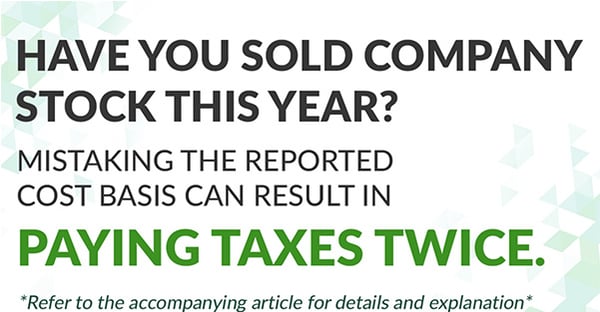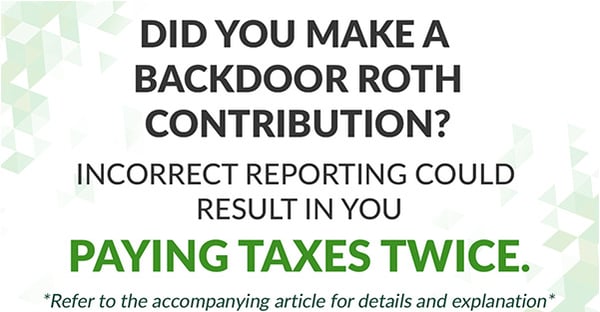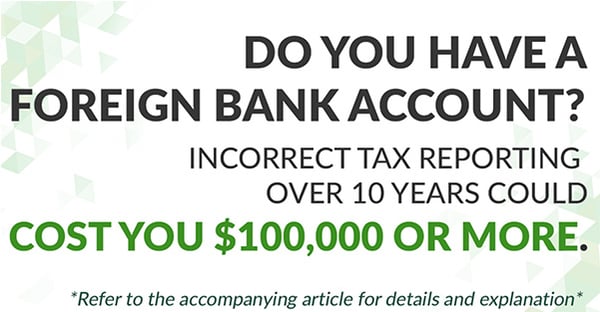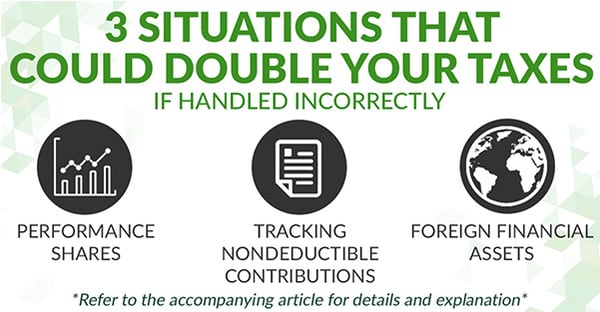Tax season — it's a time that invokes anxiety and distress across the country until April 15th (for 2025) comes and goes. When we advise our clients, we review their tax returns for tax planning opportunities and often find previously made errors that result in incorrect amounts of additional tax due. These errors range in severity and difficulty to fix, but they can be significant enough to cause sizeable tax ramifications if not addressed quickly and effectively. This article addresses three tax reporting errors that we see most often, how they've been brought about, and how they can be addressed. We'll also dive into a few of the errors we see from high-income earners that can be fixed simply, but let's start with the costliest mistakes.
Mistake #1 — Getting Taxed Twice for Your Restricted Stock or Stock Options
Many executives receive restricted stock or stock options of their employer’s stock as part of their compensation package. When these shares are granted, or received by the executive, the value of the shares is included in their Form W-2 as taxable compensation. This value then becomes their “basis” in the shares and should reduce the gain when the shares are ultimately sold. The error we see far too often is the use of the incorrect basis when the shares are subsequently sold, which results in incorrect tax liability from double-taxation of the gain.
This error is best illustrated through the use of a simple example.
Example. Under your employer’s compensation plan, in 2020, you were granted the opportunity to purchase 1,000 non-qualified stock options at $10 per share. The stock was worth $50 per share at the time of the grant.
The difference between the value at the time of grant ($50 x 1,000 shares = $50,000) and what you paid ($10 x 1,000 = $10,000) is called a bargain element. The bargain element of $40,000 is considered taxable compensation to you in the year of the grant.
In 2024, you sell the stock at $95 per share.
To break this down:
|
Action |
Year |
# of Shares |
Share Price |
Total |
|
Shares are granted |
2020 |
1,000 |
$10 |
$10,000 |
|
Shares are sold |
2024 |
1,000 |
$95 |
$95,000 |
In 2020, the year of grant:
When your employer granted you 1,000 shares of stock valued at $50 in 2020, the bargain element ($40,000) was considered taxable compensation and was included in box 1 of your 2020 Form W-2. When you filed your 2020 tax return, you reported the amount in box 1 of your W-2 on line 7 (salaries and wages) of the return.
In 2024, the year of the sale:
When you sell the shares in 2024, you will receive a Form 1099-B from your brokerage company showing the sale of those 1,000 shares for $95,000. The brokerage company is required to report on Form 1099-B what you paid for the stock as a “cost basis”. You paid $10 per share for 1,000 shares, so your basis is $10,000. Therefore, $10,000 is shown as your cost basis on Form 1099-B. You report this sale on your 2024 tax return as follows:
Sale ($95,000) - Cost Basis ($10,000)
This results in $85,000 of income for you in 2024 which is taxable at long-term capital gain rates.
All good, right? You're using the information provided on Form 1099-B for your tax return and it seems pretty straightforward.
However, in doing so, you've actually made a costly mistake — Double-Taxation. You have reported the $40,000 of bargain element into taxable income twice.
The Tax Impact of Incorrect Cost Basis for Performance Shares
In our example, the bargain element of $40,000 was included in taxable income in 2020 as taxable compensation on Form W-2. It was again included in taxable income when the shares were sold at a long-term capital gain of $85,000. Assuming that, as an executive, you are taxed at the highest capital gains rate of 20%, plus the additional 3.8% net investment income tax, this will result in an incorrect tax liability on the sale of $20,230.
The correct method of reporting this grant of 1,000 shares to you is as follows:
|
Year |
Form of Income |
Line or Schedule of Form 1040 |
Amount of income |
|
2020 |
Salary |
Line 7 of 2018 Form 1040 |
$40,000 |
|
2024 |
Long-term capital gain |
Form 8949 |
$45,000 |
You may be asking why only $45,000 in capital gains for 2024? You have already paid tax on the grant of the stock in 2020 because your employer included the $40,000 in your Form W-2. Any amount that you’ve already paid tax on should be added to your cost basis.
Therefore, your total cost basis in the shares is computed as follows:
Amount you paid for shares in 2020 ($10 per share): $10,000
Amount of income taxed in 2020 as compensation: $40,000
Total cost basis: $50,000
So you will only be taxed on the actual gain incurred as follows:
Sale of 1,000 shares at $95 in 2024: $95,000
Less: total cost basis: ($50,000)
Total long-term capital gain: $45,000
Most taxpayers (and sometimes their CPAs) report exactly what is shown on their Forms 1099-B when they prepare their yearly tax returns. However, a little-known regulation of the IRS is that brokers (like Fidelity, Edward Jones, UBS, Charles Schwab, etc.) are not allowed to include ordinary income on Forms 1099-B. This is why, in our example, Form 1099-B reflected only $10,000 as a cost basis. If a taxpayer is not keeping track of which shares are being sold, they will get this wrong every time.
How to Prevent Double-Taxation On Your Performance Shares
What is a solution? Many brokers, like Fidelity, provide important details in their Supplemental Information included with the yearly Forms 1099-B. Taxpayers (and their CPAs) need to look beyond Form 1099-B and into the Supplemental Information for information that will prevent double-taxation.
Fidelity has online resources to walk taxpayers through both Forms 1099-B and the accompanying Supplemental Information. This publication can be found here.
Going back to our example, when you sell your 1,000 performance shares in 2024, you will need both the Form 1099-B and the Supplemental Information section included with your Form 1099-B when you prepare your tax return.
By reporting this sale correctly, you will only recognize into income the $45,000 of capital gain income resulting from the sale of the shares. Assuming you are in the 20% capital gains rate, with the additional 3.8% net investment income tax, this results in a tax of $10,710. This is $9,520 less than the tax liability incurred by the double taxation from incorrect reporting.
If you're receiving performance shares as part of your executive compensation, you should consult the Supplemental Information included with your Form 1099-B when preparing your tax return. If you're using tax preparation software, this information will guide you in entering the data correctly. If you use a CPA, you should provide them with this Supplemental Information section of Form 1099-B to ensure accuracy in the preparation of your tax return.

How to Address Double Taxation on Previous Tax Returns
If you have made this error on a prior year’s tax return, you can amend the three most recently-filed tax returns by filing a Form 1040-X, Amended U.S. Individual Income Tax Return to get a refund of any taxes you may have overpaid.
If you choose to amend a return to correct the error, it must be filed within three years of that return's original filing date. For example, if you made a double-taxation error on your 2022 return, you would need to file an amended return no later than April 15, 2025.
Mistake #2 — Incorrectly Completing or Filing Form 8606
When discussing tax returns with our clients, the most common mistakes we see from corporate executives and small business owners are related to Form 8606.
Form 8606, "Nondeductible IRAs," is filed with your Form 1040 and is used to report:
- Nondeductible contributions you make to traditional IRAs,
- Distributions from traditional, SEP, or SIMPLE IRAs (if you’ve ever made nondeductible contributions to traditional IRAs),
- Roth conversions, and
- Distributions from Roth IRAs.
The two most common errors we have encountered are failure to complete Form 8606 and failure to report a Roth conversion correctly.
Failure to complete Form 8606 and attach to Form 1040
If you make a nondeductible contribution to a traditional IRA, you should complete Form 8606 to track your basis in the IRA. The basis is composed of amounts that have already been taxed (“after-tax” amounts). Without Form 8606, you don't have the necessary or sufficient documentation to prove your basis in the IRA. This results in double-taxation when you receive distributions from the IRA.
For example, Joanna’s taxable income is too high to receive a deduction for a contribution to an IRA. In 2022, when she was 64 years old and still employed, she contributed $7,000 as a nondeductible contribution to her traditional IRA. Because she receives no deduction for the contribution, the the$7,000 is considered after-tax money. She should include this into her “basis” of her IRA.
Since Joanna will not receive a deduction for the contribution, she forgets to tell her CPA, and her CPA doesn’t ask her whether she made a nondeductible contribution. Therefore, no Form 8606 is filed with her tax return tracking this contribution.
The IRA earns a total of $500 in 2022 and 2023. In 2024, Joanna distributes the entire balance of $7,500. She receives a Form 1099-R for the distribution of $7,500 with the “Taxable Amount Not Determined” box of Form 1099-R is checked. The CPA reports the entire $7,500 distribution into taxable income.
The problem is that Joanna has already paid income tax in 2022 on the original contribution of $7,000 since it was made with after-tax money. Assuming she has no other traditional IRAs, the only amount that should be taxed is the cumulative earnings of $500. If she doesn’t correct this error, her mistake can cost her upwards of $2,400 in additional taxes if she is taxed at the highest tax bracket.
To report a nondeductible contribution to your traditional IRA, use lines 1 - 5 of Form 8606. If you use a tax return preparer, make sure you tell your CPA about your non-deductible contribution.
Failure to Report Backdoor Roth Conversion
Taxpayers whose modified Adjusted Gross Income (AGI) exceeds certain thresholds are prohibited from contributing directly to a Roth IRA. The IRS does permit these taxpayers, however, to make a nondeductible contribution to a traditional IRA and then convert that traditional IRA to a Roth. This is called a Backdoor Roth IRA conversion.
If you have performed a Backdoor Roth conversion, you must tell your CPA and provide the Form 1099-R, and Form 5498 (which details this conversion). Otherwise, your CPA will not know about the conversion. This error in not sharing information results in either 1) no Form 8606, or 2) an incomplete Form 8606.
The Backdoor Roth requires all sections of Form 8606 to be completed. Parts I and II of the form report both the nondeductible contribution to the traditional IRA and the conversion to the Roth, computing the taxable portion of the conversion if any. Part III of the form tracks your basis in the Roth IRA.
If you have incorrectly completed Form 8606 on previously filed tax returns, you can amend the three most recently-filed tax returns. If you have filed no Forms 8606 for nondeductible contributions, the IRS may accept a filing of Forms 8606 for all years to establish the correct basis in your Traditional IRA.

Mistake #3 — failure to report foreign financial assets.
Many executives live overseas as expatriates, either working for US employers or foreign employers. While overseas, they may open bank accounts, investment accounts owning mutual funds and securities, participate in the pension plans of foreign employers, own precious metals, and possibly own rental property.
Many US taxpayers believe that if the asset is held outside the US, then the income does not need to be reported on the US tax return. However, this is a very costly error.
Here are two general rules to know:
- US citizens report worldwide income and foreign financial assets on their Form 1040 regardless of where they live in the world;
- Non-US citizens report worldwide income and foreign financial assets on their Form 1040 if they reside in the US or within a US territory.
The IRS began to scrutinize this issue several years ago and has implemented costly penalties for failure to report not only the income from foreign assets but also information about foreign assets. The penalties are costly, beginning at $10,000 per reporting violation.
The Financial Impact of Failing to File Foreign Financial Assets
For example, Armand is a U.S. citizen residing in Belgium working for a foreign employer. He has a bank account, a savings account, and a pension account being held in Belgium. The combined amount of the accounts is $545,000.
Not understanding the U.S. foreign filing requirements, he failed to report these accounts on a yearly FinCEN 114 (FBAR), and Form 8939. His potential penalty is $10,000 per account per year he failed to file. If Armand is found by the IRS to have willfully failed to file, the penalties could be much higher.

Handling Delinquent Foreign Filing Requirements
If you have not been filing foreign information returns, the IRS does have procedures in place for becoming compliant. These are the Delinquent International Information Return Submission Procedures (DIIRSP), and these procedures are available for taxpayers who:
- have not filed one or more required international information returns,
- have reasonable cause for not timely filing the information returns,
- are not under a civil examination or a criminal investigation by the IRS, and
- have not already been contacted by the IRS about the delinquent information returns
If a taxpayer has reasonable cause for not filing the required information returns, they may attach a “reasonable cause” statement to the delinquent information return. Be aware, however, that the IRS may still assess penalties for the failure to file these forms. Taxpayers who qualify for the DIIRSP should speak with a knowledgeable tax professional or tax attorney about becoming compliant in this area. If the IRS discovers that you have not been filing these reports, the penalties are so costly that you may have to liquidate some of those assets to pay the IRS. At Willis Johnson & Associates, we have a strong network of professionals who can guide you in this area. You can learn more about our specialized experience here.
Which Foreign Assets and Accounts Need to be Reported?
|
If you: |
Then file: |
|
Have financial interest or signature authority over foreign financial accounts with aggregate values at any time during the year exceeding $10,000 |
FinCen 114, Report of Foreign Bank and Financial Accounts. Deadline is April 15, with automatic extension to October 15. |
|
Own any of the following: 1. Financial accounts (bank, investment, etc.) maintained in a foreign financial institution, 2. Foreign stock and securities not held in a foreign financial institution, 3. Any interest in a foreign entity (including capital or profits interest, and an equity or debt interest) 4. Any financial instrument or contract that has an issuer or counterparty that is not a US person, 5. Any cash value life insurance or annuity contract maintained by an insurance company or foreign financial institution, 6. A note, bond, debenture, or another form of debt issued by a foreign person, 7. An interest rate swap, currency swap, basis swap, interest rate cap, interest rate floor, commodity swap, equity swap, equity index swap, credit default swap, or similar agreement with a foreign counterparty, 8. An option or other derivative instrument entered into with a foreign counterparty or issuer. |
Form 8938, Statement of Specified Foreign Financial Assets, if you meet the filing threshold levels provided in the instructions to the Form 8938. File with your Form 1040. |
|
Own an interest in a Passive Foreign Investment Company (PFIC) — including foreign mutual funds — and receives direct or indirect distributions or dividends from the PFIC (including a foreign mutual fund) or recognize a gain or a direct or indirect disposition of the PFIC stock or foreign mutual fund. |
You may be required to file Form 8621, Information Return by a Shareholder of a Passive Investment Company or Qualified Electing Fund. |
|
Need to report information with respect to a Qualified Electing Fund (QEF) or Section 1296 mark-to-market election |
You may be required to file Form 8621, Information Return by a Shareholder of a Passive Investment Company or Qualified Electing Fund. |
|
Are an officer, director, or shareholder in a foreign corporation(s) |
You may be required to file Form 5471, Information Return of U.S. Persons With Respect To certain Foreign Corporations. File with your Form 1040. |
|
Own or are beneficiary of a foreign trust |
You may be required to file Form 3520, Annual Return to Report Transactions With Foreign Trusts and Receipt of Certain Foreign Gifts. |
|
Receive bequests or gifts in a certain amount from a foreign individual, estate, corporation or trust. |
You may be required to file Form 3520, Annual Return to Report Transactions With Foreign Trusts and Receipt of Certain Foreign Gifts. |
|
Own an interest in a foreign partnership. |
You may be required to file Form 8865, Return of U.S. Persons With Respect to Certain Foreign Partnerships. |
Common Tax Mistakes You Can Easily Fix This Tax Season
In addition to the three biggest tax mistakes we see regularly, I want to also discuss smaller mistakes that can have a big impact.
Improper Tax Withholding
Something we see happening often is taxpayers ignoring how much is being withheld from their salary. Perhaps they are having too much or too little withheld out of their salaries. This is easy to check and there is really no reason to have either very large overpayments or very large payments due.
For taxpayers who are thrilled to receive huge refunds from the IRS each year—this is money you would have had throughout the year had you adjusted your withholding. There are no victory laps for having huge refunds. Likewise, if you have large payments to the IRS each year because of insufficient withholding or income that is not withheld upon (dividends, business income, passive income), this too is an easy fix through either adjusting your withholding or making quarterly estimated tax payments.
Poor Record-Keeping
Another common mistake is poor record-keeping. IRS audits do happen and can be a significant cost if you do not have the proper documentation to support the numbers claimed on your return. For example, I’ve seen clients who withdraw large amounts from their children’s 529 plans but fail to keep the records of the expenses those withdrawals were made to cover. The same thing for Health Savings Accounts. Taxpayers withdraw from those accounts and do not keep the receipts for the expense that was reimbursed. You may think the IRS will never audit you, but how do you really know that? If the IRS audits these withdrawals and you do not have the records to support them, the IRS will consider that taxable income to you and assess back taxes, along with penalties and interest. How much easier it is to keep track of receipts? So, keep good records. Make sure you have proper documentation that supports every number and position you are claiming on your tax return.
Procrastination on Tax Preparation
And another mistake—waiting until the last minute to prepare your tax return, or provide your documents to your CPA. There must be time to correctly prepare a tax return, whether you are preparing or a tax professional is preparing.
When you wait until the last minute, there is a great risk that 1) mistakes will happen in the preparation due to haste and lack of well-qualified review, 2) assumptions will be made and positions will be taken that cannot be supported by facts and documentation, and 3) incorrect numbers will be used. Through the years as a tax professional, I’ve seen many a client wait until the last minute for tax preparation. This isn’t good for you, and it sure isn’t good for your tax professional.
These tax mistakes are the ones we often see impacting our clients the most. Failing to report foreign assets, double taxation, and failure to include correct documentation are only a few of the many potential tax filing mistakes that can significantly impact your wealth accumulation over time, but as noted, we see many others as well.
At Willis Johnson & Associates, we believe that optimizing your taxes is an important piece of your financial plan and is essential to helping you achieve your financial goals. Learn more about the services we offer and our commitment to helping your family make the most of your resources at every stage of life.








